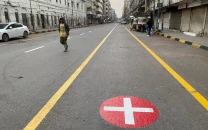Karachi's GHG emissions
.

Following Sindh's pioneering establishment of a Climate Change Directorate, Karachi has now demonstrated leadership by developing and releasing its Climate Action Plan (K-CAP). This initiative, while acknowledging the inherent challenges of implementation, signifies a crucial step forward.
The city's Mayor deserves commendation for this effort, which sets a precedent for local governance. The focus now shifts to the Karachi Metropolitan Corporation's (KMC) execution of the plan, as its success hinges on prioritised and effective actions. It's essential to recognise that this plan provides a critical baseline for analysing future greenhouse gas (GHG) emission trends, demonstrating the courage required to publish such vital data.
A significant challenge lies in the widespread misunderstanding between air pollution and GHG emissions. While air pollution involves harmful contaminants in the lower part of the first layer of the atmosphere, greenhouse gases elevate to the upper part of the troposphere, intensifying heat retention.
In Karachi, while numerous attempts have been made to measure air pollution, these have often been limited to PM2.5 monitoring. In contrast, the KMC, supported by C40 (a global cities network) and UNDP Pakistan, has successfully quantified GHG emissions, publishing the results in their climate action plan. This achievement provides a 2022 baseline for Karachi's GHG inventory, enabling future assessments of emission changes. Previously, without a situational analysis, emission reduction was difficult; Karachi has now overcome that obstacle.
The K-CAP document provides a foundational GHG emissions inventory for Karachi for the year 2022, stating a total of 43.5 million metric tons (MMT) CO2-equivalent. This inventory identifies the key sectoral contributions, with Stationary Energy dominating at 67.5% (29.4 MMT-CO2e), followed by Waste at 18.7% (8.14 MMT-CO2e) and Transport at 13.8% (6.01 MMT-CO2e).
Within the Stationary Energy sector, manufacturing industries and construction account for the highest emissions (56.5%), followed by residential buildings (27%). The Waste sector's primary contributor is unmanaged solid waste disposal (59% of waste emissions), while on-road transportation is the major source within the Transport sector (99.7%).
Karachi's report on GHG emissions was made using a widely accepted method that tracks three main types of emissions: carbon dioxide, methane and nitrous oxide. The study focused on emissions from buildings including all types of manufacturing concerns, vehicles and waste.
To measure the emissions, experts used a standard calculation tool. They gathered data on how much fuel (like natural gas, LPG, petrol, coal and diesel) was used in homes, businesses and vehicles, then estimated emission levels based on global guidelines. The report covers all of Karachi's districts and breaks down how different fuels contribute to pollution.
This BASIC-level inventory, while providing a crucial starting point for climate action, prioritises major emission sectors, notably stationary energy and waste, where unmanaged solid waste is a key contributor, and also includes emissions from domestic wastewater.
Notably, it excludes deforestation as a direct emission source, which aligns with the BASIC-level's focus and Karachi's primarily urban nature. The inventory's reliance on the globally accepted standards, methods and guidelines to calculate the GHG emissions of a mega city like Karachi enhances transparency and facilitates comparisons with other cities, aiding in prioritising mitigation efforts.
Future inventories at a BASIC+ or territorial level — more advanced methods - may include emissions from Industrial Processes and Product Use (IPPU) and Agriculture, Forestry and Other Land Use (AFOLU).
Karachi's first-ever K-CAP marks a crucial step forward, yet key weaknesses at the mitigation side must be addressed to ensure real impact. While the report outlines GHG emissions with commendable ambition, its foundation (the data sources) lack transparency.
Where exactly did the numbers come from? How were fuel consumption, waste and industrial emissions measured? Without these details, confidence in the findings remains shaky. What was the reason to consider various varieties of all types of fossil fuel as of same quality and how the undocumented part of economy was treated while doing this exercise?
The inventory also takes a narrow view, omitting major emission sources like imported goods (clothing, electronics) and land-use changes. If Karachi plants thousands of trees but ignores deforestation's hidden carbon toll, can it claim true progress? Similarly, the 2022 emissions snapshot is useful, but without past trends, how do we gauge improvement?
Most concerning is the missing link between data and action. The report identifies manufacturing as the top emitter (56.5% of energy sector emissions), but will this directly translate into stricter factory regulations or renewable energy shifts? Without independent verification, even the best numbers risk becoming just paperwork.
KMC's effort is pioneering; but to move from promise to results, the next steps must be sharper: open data, broader emission tracking and clear policy ties. The city's fight against climate change deserves nothing less.
In conclusion, the GHG inventory management process for Karachi, as presented in K-CAP, provides a necessary and commendable initial assessment of the city's carbon footprint using a recognised methodology. However, enhancing the transparency of data sources and collection methods, expanding the scope of the inventory in future updates and establishing clear linkages between the inventory data and targeted climate actions would strengthen its utility as a tool for driving effective climate mitigation in Karachi.
The absence of specific data on deforestation as a direct emission source in a predominantly urban context is understandable at the BASIC-level, but future expansion to include land-use change could provide a more holistic view.














COMMENTS
Comments are moderated and generally will be posted if they are on-topic and not abusive.
For more information, please see our Comments FAQ